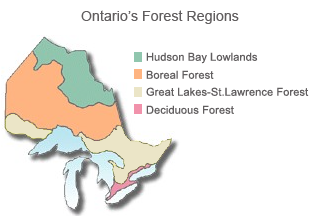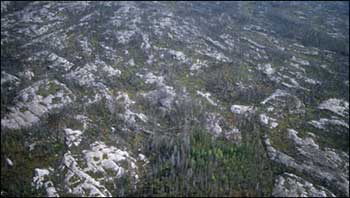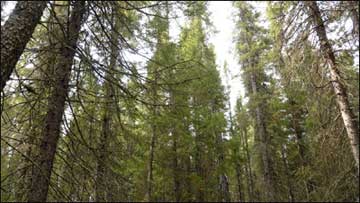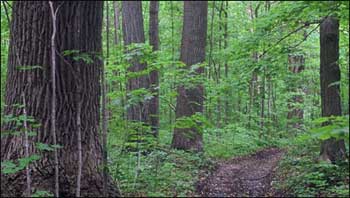Forest regions
Learn about Ontario’s four forest regions.
Ontario’s forest regions
There are four main forest regions in Ontario, each with unique characteristics and species:
- the Hudson Bay Lowlands in the far north
- the boreal forest region in the northern Ontario
- the Great Lakes–St. Lawrence forest in southern and central Ontario
- the deciduous forest in southern Ontario
Most of Ontario’s population lives within the Great Lakes–St. Lawrence and deciduous forest regions.

Hudson Bay Lowlands
Distinguished by bogs and fens, sparse slow growing forest and tundra, the Hudson Bay Lowlands is the northernmost forest region in Ontario.

This forest has one of the largest expanses of wetland in the world. With an area of 26 million hectares, it is dominated by trees and open muskeg (over two-thirds of its area) and is dotted with thousands of small lakes and ponds.
This region is:
- 26.3% of Ontario’s area
- 2.3% within the Area of the Undertaking
- 24.2% forest cover

Productive forest is generally made up of stunted tamarack and black spruce growing along river banks and other well-drained areas. White birch, dwarf birch and willow are the common deciduous trees in this forest region.
The Hudson Bay Lowlands region provides vital habitat for a variety of unique mammals and migratory birds including:
- woodland caribou, polar bear, arctic fox, and arctic hare
- Canada geese, snow geese, willow ptarmigan and various species of sea ducks

Boreal forest region
Ontario’s boreal forest is the largest forest region in Ontario and Canada. With an area of 50 million hectares, the boreal forest contains two-thirds of Ontario’s forest. It extends from the northern limits of the Great Lakes–St. Lawrence forest to the Hudson Bay Lowlands.

This region is:
- 50% of Ontario’s area
- 58% within the Area of the Undertaking
- 74% forest cover

Coniferous (softwood) and mixed-wood forests dominate the Boreal region. The main conifer species are black and white spruce, jack pine, balsam fir, tamarack and eastern white cedar. The predominant deciduous (hardwood) species are poplar and white birch.
Boreal forests are heavily influenced by natural disturbances. Although large, intense fires often burn across the landscape, boreal species have adapted to this. As part of their life cycle, species like jack pine and black spruce require this kind of disturbance to regenerate. New forests quickly grow after these disturbances, creating the natural pattern of even-aged, single species forests found in the boreal region.
The boreal forest contains hundreds of species of plants such as ferns, mosses, fungi, shrubs and herbs.
It is also home to a wide variety of wildlife, including:
- predators such as black bears, wolves and lynx
- large ungulates like moose and caribou
- a myriad of birds ranging from the great owl to the tiny winter wren
- many small mammals such as the pine marten, hare, red fox and porcupine

Great Lakes–St. Lawrence forest region
The Great Lakes–St. Lawrence forest is the second largest forest region in Ontario. It covers approximately 20 million hectares of Ontario. This forest extends along the St. Lawrence River across central Ontario to Lake Huron and west of Lake Superior along the border with Minnesota. The southern portion of the Great Lakes–St. Lawrence forest extends into the populated areas of Ontario.

This region is:
- 20% of Ontario’s area
- 70% within Area of the Undertaking
- 62% forest cover

The Great Lakes–St. Lawrence forest is dominated by hardwood forests, featuring species such as maple, oak, yellow birch, white and red pine. Coniferous trees such as white pine, red pine, hemlock and white cedar, commonly mix with deciduous broad-leaved species, such as yellow birch, sugar and red maples, basswood and red oak. Much of the forest in the Great Lakes–St. Lawrence forest is uneven aged, meaning that young and old trees can be found within the same group of trees.
The Great Lakes–St. Lawrence region is home to a wide variety of wildlife, including:
- predators such as black bear, wolves
- large ungulates like white-tailed deer and moose
- many small mammals such as beaver, muskrat, otter
- pileated woodpecker and various migratory birds

Deciduous forest region
The deciduous forest is the southernmost region in Ontario, dominated by agriculture and urban areas. Totaling almost 3 million hectares, this region has largely been cleared with scattered woodlots remaining on sites too poor for agriculture. This forest generally has the greatest diversity of tree species, while at the same time having the lowest proportion of forest.

This region is:
- 3% of Ontario’s area
- 0% within Area of the Undertaking
- 10.3% forest cover

It has most of the tree and shrubs species found in the Great Lakes–St. Lawrence forest, and also contains black walnut, butternut, tulip, magnolia, black gum, many types of oaks, hickories, sassafras and red bud — species commonly found in Ohio, Pennsylvania and the Carolinas in the USA.
The deciduous forest region has the most diverse forest life in Ontario. The region has many rare mammals, birds, plants, insects, reptiles and amphibians such as:
- sassafras and tulip tree
- southern flying squirrel and red-bellied woodpecker
- black rat snake, milk snake and gray tree frog
